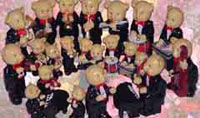Peter Paul Rubens, ピーテル・パウル・ルーベンス
Above is just a small part of our gift-packed souvenir stamp-collection; inquire by email if the picture or subject of your interest is not here: we will be obliged to accomodate your wishes.
ここに掲載の写真は一部のみです。ご希望のジャンル、絵柄などございましたらお問い合わせください。
ピーテル・パウル・ルーベンス(Pieter Paul Rubens, 1577年6月28日 - 1640年5月30日)は、バロック期のフランドルの画家。現地音は「リュベンス」に近い。
目次
[非表示]
1 生涯
2 『マリー・ド・メディシスの生涯』
3 外交官としての一面
4 代表作
5 その他
生涯
17世紀、バロック時代のヨーロッパを代表する画家である。ルネサンス期絵画の均整のとれた構図や理想化された人物表現とは一線を画し、ルーベンスの絵画は、動きの多い劇的な構図、人物の激しい身振り、華麗な色彩、女神像などに見られる豊満な裸体表現など、バロック絵画の特色が十二分に発揮されたものである。人物のまとう毛皮の色などに、黒を色彩のひとつとして積極的に用いていることも特筆される。
1577年、アントワープ(アントウェルペン)出身だった両親が亡命していた先の、ドイツのジーゲンに生まれた。ルーベンスが10歳の時に父親が没し、母親はルーベンスを連れて故郷へ戻る。絵の修業を始めたのは14歳頃からである。師匠の一人であったオットー・ファン・フェーンは、ギリシア・ローマの古典に造詣の深い、教養ある人物で、ルーベンスはこの師から多大な影響を受けている。
1600年にはイタリアへ渡り、マントヴァ公の宮廷画家となった。イタリアで約8年間活動した後、1608年にはアントワープに戻っている。1609年、長らく争っていた隣国オランダとの間に休戦協定が結ばれ、平和が戻ったフランドルでは絵画の需要が急増し、イタリア帰りのルーベンスには注文が殺到した。この年からスペインのイザベラ王女(ネーデルラントの統治者でもあった)の宮廷画家となったルーベンスは、前世紀のヴェネツィアの画家同様、工房を設置し、多くの弟子たちを動員して大量の注文制作をこなした。
マリー・ド・メディシスの生涯:マリーのマルセイユ到着 1622−25 ルーヴル美術館
『マリー・ド・メディシスの生涯』
ルーベンスは1622年、パリに赴き、当時のフランス皇太后マリー・ド・メディシスの注文による、彼女の生涯を題材とした連作の制作にとりかかる。マリー・ド・メディシスはその名が示すとおり、フィレンツェのメディチ家の出身で、フランス王アンリ4世の妃であり、ルイ13世の母である。マリー・ド・メディシスは、その権勢欲の強さから、息子である国王ルイ13世と対立し、ついには王宮から追放されてしまう。この連作は、そのマリーが、リュクサンブール宮殿に飾るために注文したものであった。偉大な業績を残したわけでもなく、ドラマ性に乏しいこの女性の一代記を絵画化するにあたり、ルーベンスは古代神話の神々や寓意の人物像などを巧みに画面に取り入れて、壮大な作品に仕立て上げている。
外交官としての一面
多くの言語に精通していたルーベンスはイタリア、スペイン、英国にも足跡を残し、外交官としての一面もあった。上述したオランダとフランドルの休戦協定の有効期間は12年間で、1621年にその期限が切れると、フランドルは再び戦火にさらされた。当時、北部ネーデルラント(オランダ)は独立していたが、フランドル(今のベルギー)は引き続きスペインの支配下にあった。1628年、前述のイザベラ王女は和平のための外交使節として、ルーベンスをスペインのマドリードに派遣した。ルーベンスはそこでスペイン最大の画家ベラスケスに会っており、またスペイン宮廷が所蔵していたティツィアーノ(ヴェネツィア派の巨匠)の絵画を模写するなど、画家としての活動もしている。
Biography
Rubens was born in Siegen, Westphalia to a successful Protestant lawyer who had fled Antwerp to escape religious persecution. In 1589, two years after his father's death, Rubens and his mother returned to Antwerp, where he had himself baptized a Catholic. Religion figured prominently in much of his later work. In Antwerp, his mother apprenticed Rubens to leading painters of the time like Adam Van Noort and Otto Venius.
In 1600 he went to Venice, Italy, where he worked as a court painter to the duke of Mantua, Vincenzo I of Gonzaga. He studied ancient Roman art and learned by copying the works of the Italian masters. His mature style was profoundly influenced by Titian.
In 1603 and 1604, he worked as a diplomat in Spain, combining art and diplomacy as he would throughout his career.
Upon the death of his mother in 1608, Rubens returned to Antwerp. A year later he married Isabella Brant, daughter of Jan Brant, a leading Antwerp humanist. He was appointed court painter by Albert and Isabella, the governors of the Low Countries.
He moved in 1610 to the Rubenshuis, a house in Antwerp that he designed for himself and which is now a museum. This house also contained his workshop where he and his apprentices made most of the paintings, his art collection, and his library, which was one of the most extensive of Antwerp. Rubens was a good friend and occasional collaborator of the family Moretus, owners of the large Plantin-Moretus publishing house.
His altarpieces The Raising of the Cross (1610) and The Descent of the Cross (1611-1614) for the Cathedral of Our Lady established Rubens as Flanders' leading painter.
He received numerous commissions from the French court, including a series of allegorical paintings on the life of Marie de' Medici (now in the Louvre). He and his workshop executed many monumental religious paintings, such as the Assumption of the Virgin Mary in the Cathedral of Antwerp. The young Anthony van Dyck was one of the assistants in Rubens' studio.
The Raising of the Cross, Cathedral of Our Lady , Antwerp
In the period between 1621 and 1630, the Spanish Habsburg rulers entrusted Rubens with a number of diplomatic missions. Charles I of England knighted him for his diplomatic efforts to bring about a peace treaty between England and Spain. He was also commissioned to paint the ceiling of the Banqueting House at the Palace of Whitehall.
Helene Fourment with two of her children, c. 1636.
In 1630, four years after the death of his first wife, the 53-year-old painter married 16-year-old Helene Fourment. Rubens had three children with Isabella and five with Helene; his youngest child was born eight months after his death. Helene's charms recur in later works such as The Garden of Love, The Three Graces and The Judgment of Paris, painted for the Spanish court and now in the Prado.
The above explanation comes from  出典: フリー百科事典"ウィキペディア"
出典: フリー百科事典"ウィキペディア"

